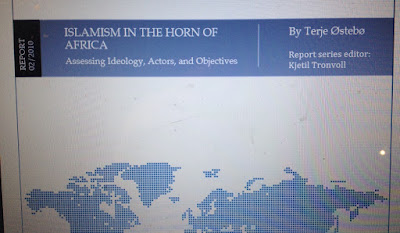March 1967
The Ethiopia extermination campaign of 1967
This just documents few of the earlier crimes.
http://www.mediafire.com/download/9iwq7dyw58ejiln/Ethiopia%27s+war+of+extermination_1967.pdf
and the reaction of the Sudanese and world press
http://www.mediafire.com/download/7xygw7en0bgjt58/Extracts+from+the+Sudanese+press+1967+on+the+Ethiopian+extermination+campaign.pdf
Thanks to Alamin Idris for sharing the documents
---------------------
Some of the most brutal massacres in 1967 were carried out by the Eritrean Commandos units. They were illiterate persons brainwashed that they are fighting an Islamic revolt. They are responsible for the crimes they committed. When they realized that they were mistaken, many joined the armed struggle. None in the ELF, ever, accused Christians of killing Muslims. Isaias Afworki and his 'Nehnan Elmanan' group spoke of atrocities committed by the ELF against Christians. They spoke of about 300 Christian university students killed by the ELF, what is known as 'Sireyt Addis'. No one has yet to produce 10 names , let alone 300. He ended up killing many Christians than what he claimed the ELF killed. He played this dangerous religious tone to split from the ELF and maintained this tone even after liberation.
Suleiman Hindi recalls that in one meeting of Isaias with fighters from PLF 1 group, in 1971, one of the fighters, Ahmed Omer Hassaballahasked Isias how do you want to form an organization of Christian fighters when you have killed 3 fighters from Akle Guzai without trial. Isaias responded, "How do you ask me about 3 fighters killed; when we all know how many Christian fighters were killed by you. We owe you 5 tankers of blood. If we were to count that, we could not have had any cooperation with you."
--------
This is also what Isaias Afeworki old to
an Amharic language magazine in Addis Ababa published in September 1997, Issue volume 1, number 1.
"If I were not aware of our own situation, I would have described the grisly mass murders in Somalia, Rwanda, former Yugoslavia and Liberia as barbaric crimes perpetrated by backward peoples. I would have said 'we are different, we are not like them'. But what we had gone through in Eritrea was not different from what is going on in other countries. We in Eritrea suffered mass murders, one ethnic and geographic group cleansing the other in a cowardly and inordinate manner. We have now come a long way from that past, and the present and future generations [in Eritrea] who had not seen what we did would be surprised of what is going on in Somalia, Yugoslavia, Rwanda and Liberia. The surprise comes because they did not know what had happened in our country. Seen from this angle, it would appear that the present and future generations would benefit from knowing about it. But unless done in a constructive way, making the new generation aware of a black spot in its history is a bit difficult".
Perhaps referring that there was a genocide against Christians in the ELF. Let alone a genocide, no one can substantiate, to date, that many persons were killed. He is a brutal murderer who has no religion, I do not think his reference to Christians is because he loves them more; but simply to extend his rule by creating divisions. Something he has mastered for a long time.
The ELF has probably killed more Muslims than Christians and Isaias has killed many, many Christians (that he was supposed to protect) than the ELF did.
----------
But when the victims keep silent, they become the accused, and the perpetrators, the accusers.
-----------
Haggai
in his book, “The Struggle over Eritrea, 1962 – 1978”, published 1983 details how Asrate
Kassa, Governor then, had close relations to Israel and with their support he
built in 1965, the ‘Commandos’, or ‘101’. By the end of 1965 it was a
battalion-size unit comprising nine superbly trained companies. Its central
base was Dekemhare, where the recruits mostly Christian Eritreans – were
trained by the Israelis. It was also known as the ‘Governor’s private army.’
He
writes, “Asrate Kassa, who saw Islam as the main enemy of Ethiopian
nationalism, seems to have initiated the anti-Muslim campaign. He had long
tried to orient Ethiopia’s regional policy on Israel, and Israeli advisors were
almost permanent guests in his Asmara Palace. Israeli victory in the six days
war contributed significantly in Asrate Kassa’s growing influence. Following
his advice, the Emperor consented to a more flexible policy in troubled
Eritrea.
A general amnesty was proclaimed, Christian Tigreans considered loyal
to the Government were armed, and Asrate Kassa met with religious functionaries
to persuade them to encourage their followers to cooperate with the Government…
By the end of 1967, some one hundred rebels, including an important Christian
leader, had surrendered.” He states that that campaign of massacring the
population and the burning of villages in coincided with return from the Adobha
meeting of the fighters of the defunct Tripartite.













